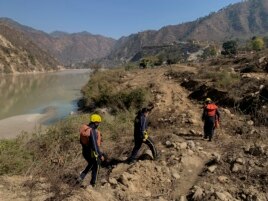08 February 2021
Indian rescuers searched on Monday for about 200 people missing after part of a Himalayan glacier broke away Sunday and caused major flooding.
The flooding happened when part of the Nanda Devi glacier broke off, releasing water trapped behind it. The burst sent floodwater toward power plants and villages in northern Uttarakhand state. The floods destroyed bridges and broke dams. Huge amounts of water, rock and building materials flowed down a mountain valley.
At least 26 people are confirmed dead.
More than 2,000 military members, police officers and others have been taking part in search-and-rescue operations.

Rescuers arrive to search for bodies in the downstream of Alaknanda River in Rudraprayag, northern state of Uttarakhand, India, Monday, Feb.8, 2021.
Most of the missing were people working on two hydroelectric power plants. The projects are part of government efforts to develop the mountainous areas of Uttarakhand state.
The floodwaters rushed down the mountain and into other bodies of water. Many villages along the Alaknanda and Dhauliganga rivers were evacuated. The two rivers flow out of the Himalayan mountains and later join with the Ganges River.
Videos on social media show the muddy, gray floodwaters quickly flowing through a valley and into a dam, and breaking it into pieces before continuing downstream.
Experts said the disaster could be linked to climate change. A team of scientists was flown to the area Monday to investigate what happened.
How glaciers and glacial lakes are formed
A glacier is a very large area of ice that moves slowly down a mountainside or valley or over a wide area of land. Glaciers are made of closely formed layers of snow. They move or flow because of gravity and the softness of ice compared to rock.
A long and narrow piece of ice called a glacier's "tongue" can extend hundreds of kilometers from its beginnings in high mountains. The end of the tongue can advance or move backward based on snowfall and melting.
Bodies of water called proglacial lakes are formed after glaciers retreat, or move back. Extra water or pressure -- or structural weakness -- can cause both natural and manmade dams to burst. This sends a mass of floodwater flowing down the rivers fed by the glacier.
Why did this glacier burst?
It is not yet known what caused part of the Nanda Devi glacier to break off.
Seismic activity and a buildup of water pressure can cause glaciers to burst. But climate change may be another cause. High temperatures, combined with less snowfall, can increase the speed of melting. This causes water to rise to possibly dangerous levels.
Sarah Das is a scientist at Woods Hole Oceanographic Institute in Massachusetts. She told The Associated Press, "Most mountain glaciers around the world were much larger in the past and have been melting and shrinking dramatically due to climate change..."
Sunday's disaster happened in the western part of the Himalayas. The mountains form part of India's long northern border.
A 2010 information page published by the International Centre for Integrated Mountain Development called for more glacier observation in the Himalayas to better understand "the real degree of glacial lake instability."
The area where the glacial burst took place experiences landslides and flooding. Environmental experts have warned against building in the region.
I'm Ashley Thompson.
Ashley Thompson adapted this story based on reports by The Associated Press and Reuters news agency. Hai Do was the editor.
______________________________________________________________
Words in This Story
glacier - n. a very large area of ice that moves slowly down a slope or valley or over a wide area of land
hydroelectric - adj. of or relating to production of electricity by waterpower
rush - v. to move very quickly
evacuate - v. to remove (someone) from a dangerous place
muddy - adj. filled or covered with mud (soft, wet dirt)
layer - n. a covering piece of material or a part that lies over or under another
advance - v. to move forward
seismic - adj. of, relating to, or caused by an earthquake
dramatically - adv. sudden and extreme
due to - adj. because of
instability - n. the state of being likely to change
region - n. a part of a country, of the world, etc., that is different or separate from other parts in some way
We want to hear from you. Write to us in the Comments section, and visit 51VOA.COM.